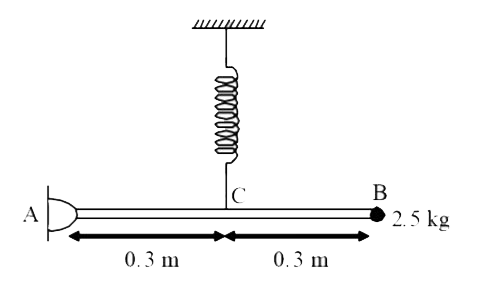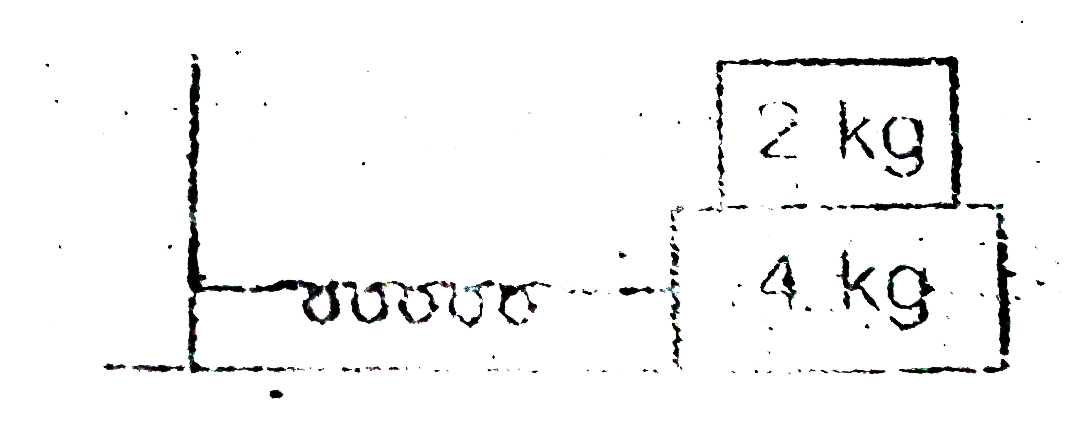Two point masses of 3.0kg and 1.0kg are attached to opposite ends of a horizontal spring whose spring constant is 3Nm−1 as shown in figure . The natural frequency of vibration so this system is n/πHz. Find the integral value of n.

The correct Answer is:1
The reduced mass of the system,
m=m1×m2m1+m2=3×13+1=34kg
So, inertia factor, m=34kg.
Here, spring factor, k=3Nm−1
Frequency v=12π√springfactorinertiafactor
=12π√3(3/4)=1πHz
As per question, nπ=1π or n=1
Topper's Solved these Questions
- BOOK - PRADEEPCHAPTER - OSCILLATIONS AND WAVESEXERCISE - Assertion-Reason Type Questions23videos
OSCILLATIONS AND WAVES
- BOOK - PRADEEPCHAPTER - OSCILLATIONS AND WAVESEXERCISE - multiple choice Questions13videos
OSCILLATIONS AND WAVES
- BOOK - PRADEEPCHAPTER - OSCILLATIONS AND WAVESEXERCISE - JEE mains adv..(multiple choice quection)150videos
OSCILLATIONS AND WAVES
- BOOK - PRADEEPCHAPTER - MATHEMATICAL TOOLSEXERCISE - Fill in the blanks5videos
MATHEMATICAL TOOLS
- BOOK - PRADEEPCHAPTER - PHYSICAL WORLD AND MEASUREMENTEXERCISE - Competiton Focus Jee Medical Entrance18videos
PHYSICAL WORLD AND MEASUREMENT
Similar Questions
Two point masses of 3.0 kg and 1.0 kg are attached to opposite ends of a horizontal spring whose spring constant is 300Nm−1 as shown in the figure. The natural vibration frequency of the system is of the order of :
 View Solution
View SolutionTwo point masses of 3.0 kg and 1.0 kg are attached to opposite ends of a horizontal spring whose spring constant is 300Nm−1 as shown in the figure. The natural vibration frequency of the system is of the order of :
 View Solution
View Solution
Knowledge Check
- Question 1 - Select One
Two point masses of 3 kg and 6 kg are attached to opposite ends of horizontal spring whose spring constant is 300Nm−1 as shown in the figure. The natural vibration frequency of the system is approximately
 A4 HzB3 HzC2 HzD1 Hz
A4 HzB3 HzC2 HzD1 Hz - Question 2 - Select One
Two blocks of masses 6 kg and 3 kg are attached to the two ends of a massless spring of spring constant 2π2N/m. If spring is compressed and released on a smooth horizontal surface then find the time period (in seconds) of each block.
A1B2C3D4 - Question 3 - Select One
A 0.20kg object mass attached to a spring whose spring constant is 500N/m executes simple harmonic motion. If its maximum speed is 5.0m/s, the amplitude of its oscillation is
A0.0020mB0.10mC0.20mD25m
A uniform thin rod has a mass 1 kg and carries a mass 2.5 kg at B. The rod is hinged at A and is maintained in the horizontal position by a spring having a spring constant 18 kNm1 at C as shown in figure. The angular frequency of oscillation is nearly-
 View Solution
View SolutionA body of mass 16 kg is made to oscillate on a spring of force constant 100Nkg−1. Deduce the angular frequency.
View SolutionThe spring constant of the spring shown in the figure is 250Nm−1. Find the maximum compression of the spring?
 View Solution
View SolutionA small block of mass 2 kg is placed on a bigger block of mass 4 kg which is attached to horizontal spring of spring constant K=500N/m as shown in figure, coefficient of friction between block is 0.2 .Maximum amplitude of system so that there is no relative slipping between blocks.
 View Solution
View SolutionA body of mass 2 kg is made to oscillate using a spring of force constant 8Nm−1 find (i) angular frequency (ii) frequency of vibration (iii) time period of vibration.
View Solution

